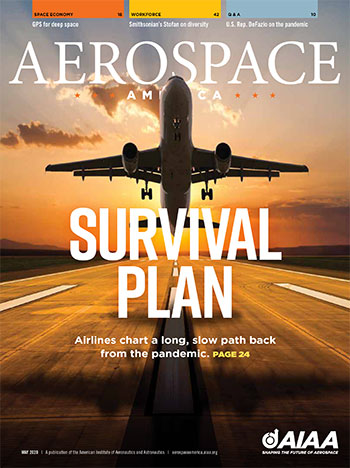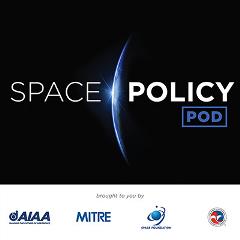Things to Do When You’re a Teleworking Aerospace Engineer or Aerospace Engineering Student
Many aerospace organizations are having their employees work from home to mitigate exposure to the coronavirus and keep communities, especially the most vulnerable members, safe and healthy. AIAA applauds and supports this decision.
We encourage everyone to follow the coronavirus safety guidelines set out by the WHO and CDC.
We understand you still have work to do and may be looking for new ways to connect while you telecommute. We can help.
For the latest updates about AIAA events and forums that have been impacted by the coronavirus pandemic visit: AIAA.org/coronavirus
If you’re a teleworking aerospace professional and have children at home, AIAA has some suggestions to keep your budding aerospace engineer busy.
Have time to update your research knowledge? Aerospace Research Central has more than 50 years’ worth of research papers.

Looking to start a conversation and hash out a technical topic? Go to Engage.
Recent topics include:
- The Potential of Space Tourism
- Looking for mentors for The American Rocketry Challenge
- Best Colleges for Aerospace
Engage community is a benefit of AIAA membership
Want to learn something new or brush up your skills? Sign up for online learning.
Looking to broaden your understanding of the latest issues in aerospace? Read Aerospace America.
Current Issue

The May 2020 issue of Aerospace America is now live. Don’t miss this month's cover story, "Action Plans," by Cat Hofacker. Also, see if you possess the knowledge to solve this month's AeroPuzzler: Surviving the Fall.
Webinars
-
 Space Policy Pod
Space Policy PodGiven the current real-world challenges confronting all of us, AIAA has joined the MITRE Corporation, Space Foundation, and the U.S. Chamber of Commerce to produce this podcast series to examine events and ideas affecting the space sector. We hope the episodes serve as an enlightening discussion on the relevant topics of the day with insights from key policymakers in the field.
Subscribe! Spotify | Apple Podcasts  Episode 5 Bhavya Lal
Episode 5 Bhavya Lal
1 July 2020
Science and Technology Policy Institute
Episode recorded 26 June 2020
This podcast features an engaging discussion with IDA Science and Technology Policy Institute expert Dr. Bhavya Lal. Dr. Lal leads strategy, technology assessment, and policy studies and analyses at the IDA Science and Technology Policy Institute for the White House Office of Science and Technology Policy, the National Space Council, and federal space-oriented organizations including NASA, the Department of Defense, and the Intelligence Community. Bhavya has published over 50 papers in peer-reviewed journals and conference proceedings. Her work is routinely covered by technical and mainstream press outlets including Space News, The Economist, Science, Chronicle of Higher Education, and National Geographic, among others.
Bhavya holds B.S. and M.S. degrees in nuclear engineering from the Massachusetts Institute of Technology, a second M.S. from MIT’s Technology and Policy Program, and a Ph.D. in Public Policy and Public Administration from George Washington University.
Key Takeaways
Counting the Space Economy
Dr. Lal emphasized that it is important to distinguish between size of the space economy and impact of the space economy. Similarly, to the electrical grid and banking system, investments in space underpin and support our broader society and economy.
The Market for Lunar Goods and Services
In analyzing the market for lunar goods and services, the Science and Technology Policy Institute found that it is unlikely that sufficient demand exists to close lunar business cases without government customers. They estimate that, at least through the 2040 timeframe, government expenditures will likely exceed private expenditures in the lunar market.
The Importance of Nuclear Power in Space
Nuclear power offers great advantages for in-space applications. The primary reason for this is the energy density of nuclear material. For example, a piece of uranium the size of a toy marble contains enough energy for an entire Mars mission. Additionally, nuclear propulsion could cut travel time to Mars by 30% or more, which would greatly reduce crew exposure to cosmic radiation.
The Importance of Investing in Foundational Technologies
The United States needs to focus on developing foundational technologies, also known as “infratechnologies”, that can accelerate innovation in other areas. In-space nuclear power is one such technology, another is on-orbit servicing, assembly, and manufacturing (OSAM). OSAM technologies could provide transformative effects on a number of fields, including science, space exploration, commercial missions, and national security.
Podcasts
-
 Space Policy Pod
Space Policy PodGiven the current real-world challenges confronting all of us, AIAA has joined the MITRE Corporation, Space Foundation, and the U.S. Chamber of Commerce to produce this podcast series to examine events and ideas affecting the space sector. We hope the episodes serve as an enlightening discussion on the relevant topics of the day with insights from key policymakers in the field.
Subscribe! Spotify | Apple Podcasts  Episode 5 Bhavya Lal
Episode 5 Bhavya Lal
1 July 2020
Science and Technology Policy Institute
Episode recorded 26 June 2020
This podcast features an engaging discussion with IDA Science and Technology Policy Institute expert Dr. Bhavya Lal. Dr. Lal leads strategy, technology assessment, and policy studies and analyses at the IDA Science and Technology Policy Institute for the White House Office of Science and Technology Policy, the National Space Council, and federal space-oriented organizations including NASA, the Department of Defense, and the Intelligence Community. Bhavya has published over 50 papers in peer-reviewed journals and conference proceedings. Her work is routinely covered by technical and mainstream press outlets including Space News, The Economist, Science, Chronicle of Higher Education, and National Geographic, among others.
Bhavya holds B.S. and M.S. degrees in nuclear engineering from the Massachusetts Institute of Technology, a second M.S. from MIT’s Technology and Policy Program, and a Ph.D. in Public Policy and Public Administration from George Washington University.
Key Takeaways
Counting the Space Economy
Dr. Lal emphasized that it is important to distinguish between size of the space economy and impact of the space economy. Similarly, to the electrical grid and banking system, investments in space underpin and support our broader society and economy.
The Market for Lunar Goods and Services
In analyzing the market for lunar goods and services, the Science and Technology Policy Institute found that it is unlikely that sufficient demand exists to close lunar business cases without government customers. They estimate that, at least through the 2040 timeframe, government expenditures will likely exceed private expenditures in the lunar market.
The Importance of Nuclear Power in Space
Nuclear power offers great advantages for in-space applications. The primary reason for this is the energy density of nuclear material. For example, a piece of uranium the size of a toy marble contains enough energy for an entire Mars mission. Additionally, nuclear propulsion could cut travel time to Mars by 30% or more, which would greatly reduce crew exposure to cosmic radiation.
The Importance of Investing in Foundational Technologies
The United States needs to focus on developing foundational technologies, also known as “infratechnologies”, that can accelerate innovation in other areas. In-space nuclear power is one such technology, another is on-orbit servicing, assembly, and manufacturing (OSAM). OSAM technologies could provide transformative effects on a number of fields, including science, space exploration, commercial missions, and national security.
Advocacy
Learn more about aerospace advocacy and reach out to policy makers.
AIAA delivers extensive technical expertise and policy guidance to decision makers at the federal and state levels, serving as a reliable resource on a full spectrum of aerospace issues such as satellite launch systems and technology, commercial space activities, airport infrastructure modernization, hypersonic vehicle technologies, aircraft manufacturing, and cybersecurity threats.


